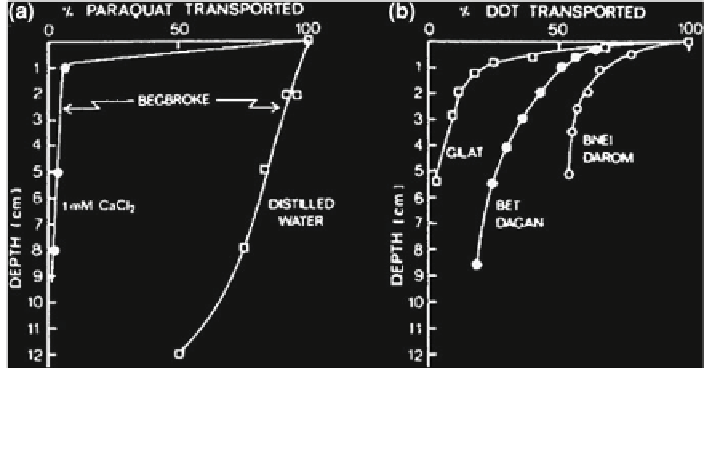Geoscience Reference
In-Depth Information
Fig. 12.44 Vertical transport of paraquat and DDT adsorbed on suspended particles (in
percentage of total applied). a
14
C-labeled paraquat adsorbed on Li-montmorillonite, b
14
C-
labeled DDT adsorbed on suspended solids in sewage effluent. Reprinted with permission from
Vinten et al. (
1983
). Copyright 1983 American Chemical Society
amount applied reached a depth of 9 cm. In the coarse sands from Bnei Darom,
54 % of the applied DDT was transported deeper than 5 cm. These differences in
transport of DDT adsorbed on organic colloids were due to differences in mobility
of the solids, which are related directly to the soil hydraulic properties and the flow
rate.
In another experiment, colloid-facilitated vertical transport of the organic
contaminant (herbicide) atrazine, which is frequently found in groundwater, was
tested under a corn field irrigated with secondary effluents containing organic
colloidal suspensions (Graber et al.
1995
). Figure
12.45
shows the distribution of
atrazine in the field irrigated with secondary effluent and the high-quality water. In
the effluent-irrigated field, atrazine was found to a depth of nearly 400 cm. Peaks
in atrazine concentration often correspond to peaks of soil organic carbon, sug-
gesting that enhanced transport is affected at least in part by complexation with
effluent-borne organic matter. In a control field where high-quality water was used
for irrigation, atrazine was concentrated only in the upper 100 cm, as soil organic
carbon decreased with increasing depth.
12.5 Transport of Nonaqueous-Phase Liquids
The behavior of nonaqueous-phase liquids (NAPLs) as they enter the partially
saturated subsurface from a land surface source follows two well-defined sce-
narios: in one case, the physical properties of the NAPL remain unchanged, while

